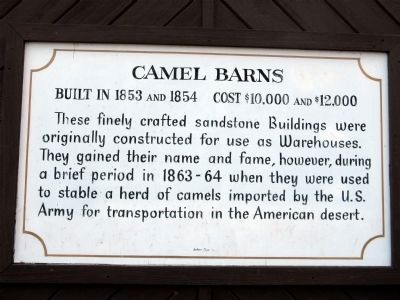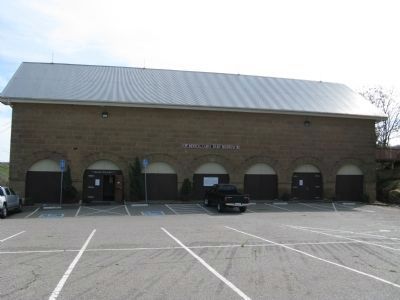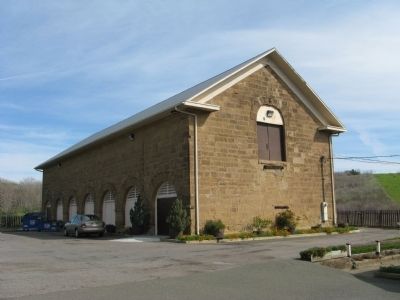Benicia in Solano County, California — The American West (Pacific Coastal)
Camel Barns
Built in 1853 and 1854, Cost $10,000 and $12,000
These finely crafted sandstone buildings were originally constructed for use as warehouses. They gained their name and fame, however, during a brief period in 1863-64 when they were used to stable a herd of camels imported by the U.S. Army for transportation in the American desert.
Erected by Benicia Historical Museum.
Topics. This historical marker is listed in these topic lists: Military • Notable Buildings • Notable Events.
Location. Marker has been reported missing. It was located near 38° 3.187′ N, 122° 8.056′ W. Marker was in Benicia, California, in Solano County. Marker could be reached from Camel Road, 0.1 miles west of Park Road. From the Benicia Arsenal Site, take Park Road up the hill and follow the signs to the Camel Barns. Touch for map. Marker was at or near this postal address: 2024 Camel Rd, Benicia CA 94510, United States of America. Touch for directions.
Other nearby markers. At least 8 other markers are within 2 miles of this location, measured as the crow flies. Commandant's Home (approx. 0.4 miles away); Gen. Quandt Lane (approx. 0.4 miles away); 1849 - Benicia Arsenal – 1964 (approx. half a mile away); Clock Tower (approx. half a mile away); World War I Memorial (approx. 1.2 miles away); Site of Benicia Seminary (approx. 1.2 miles away); 1854 – Saint Paul’s Episcopal Church – 1954 (approx. 1.2 miles away); Saint Paul's Episcopal Church (approx. 1.2 miles away). Touch for a list and map of all markers in Benicia.
More about this marker. Marker is mounted on the front wall of the Captain Charles P. Stone Hall.
Regarding Camel Barns. The Benicia Camel Barns are now the site of the Benicia Historical Museum.
See "Nearby Marker" 1849-Benicia Arsenal-1964 for additional information.
Related markers. Click here for a list of markers that are related to this marker. — Markers documenting the Army's camel experiment.
Also see . . . Benecia Historical Museum. Museum website homepage (Submitted on June 13, 2022, by Larry Gertner of New York, New York.)
Additional commentary.
1. Camel Barns 1853 – 1854
The curious name for these sizable sandstone warehouses has an even more unbelievable origin. Camels were imported by the Army in 1856-57 to transport military supplies and materials into the Southwest desert. The “experiment” was terminated in 1863 leaving the Army with 35 surplus camels. The herd was driven to Benicia and housed in these storehouses until they were auctioned off in 1864.
Source: Historic Benicia Walking Tour Brochure
— Submitted February 21, 2009, by Syd Whittle of Mesa, Arizona.
Credits. This page was last revised on October 18, 2023. It was originally submitted on February 21, 2009. This page has been viewed 6,251 times since then and 122 times this year. Last updated on August 23, 2020, by Diane Phillips of Pittsburg, California. Photos: 1, 2, 3, 4. submitted on February 21, 2009, by Syd Whittle of Mesa, Arizona. • J. Makali Bruton was the editor who published this page.



